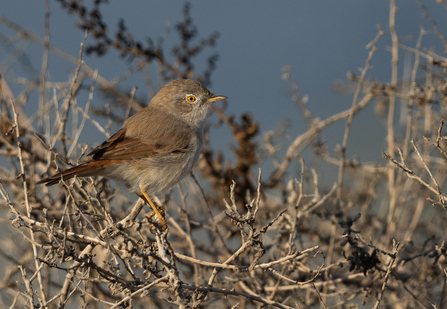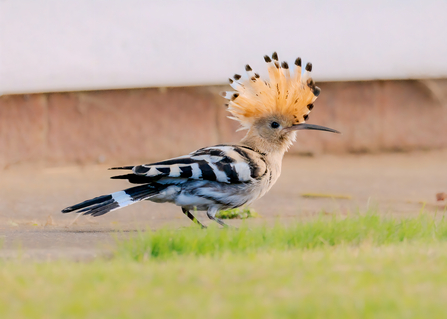Like many people, I feel mixed emotions during nature’s transition from summer to winter. The smell of rotting vegetation, the heavy still mists, and the hues of yellow, rust red and beige inspires melancholic emotions; even the garden robin adopts a gentle song, heart-breaking in its sweet sadness. But autumn for me is also a season of beauty and tranquillity. A fresh November morning, dense with dew, has a gentleness that belies the deceptively frantic activities of our wildlife. Jays and squirrels work tirelessly attempting to hide a scattering of acorns. Hedgehogs, bats and brimstone butterflies search for safe places to hibernate, and fungi push up strange looking spore laden bodies. Autumn is also the time of migration, with millions of birds heading south, some arrive with us from colder climes, others depart on an increasingly perilous journey to Africa.

Asian desert warbler (Credit: Dr Ajay Kumar Singh)
October and November are the months that rare vagrant birds drop in, and at the time of writing Norfolk has already had a few to send twitchers’ pulses racing. An Asian desert warbler appeared for a few days in early October at Natural England’s Winterton Dunes reserve, the sparse sandy habitat a reminder perhaps of its far-off homeland. Its closest breeding ground is east of the Caspian Sea; how these poor birds get their migration so incredibly wrong is astounding. After being spied upon and photographed by hundreds of birdwatchers, it moved on after a couple of days – to where? Who knows! It goes to prove that nature reserves are vital, not just for our resident wildlife, but as stopping off and ‘re-fuelling’ points for migrant birds and insects, wherever they come from or are going to.

African hoopoe (Credit: Lynne Warner)
The term ‘rare’ can be rather confusing to non-birdwatchers. A bird can be rare due to its low numbers in a particular region, or it could have a very low population across its whole range. Birds such as the Asian desert warbler maybe very common in Asia, but exceptionally unusual in Britain. In fact, this was only the 7th record for the UK. Another example is the hoopoe, it can be found here occasionally during migration, but it is a bird many of us are more familiar with from summer holidays in the Mediterranean. It always draws attention, even from those unacquainted with it, due to its striking cinnamon plumage, black and white wings, and impressive crest. A rather obliging individual spent a week in North Walsham, even making it into the Eastern Daily Press. The hoopoe was a scarce, but regular, breeding bird in southern England during the 18th and 19th century. Where I formerly lived, in Upminster, the rector of St. Laurence’s church, Rev. William Derham (circa 1720) became the first person to measure the speed of sound, and the effects air pressure has on it. A man of science and God. He is also noted for finding a pair of hoopoe nesting in the churchyard. He described both birds in great detail, and with great fondness for their beauty. However, it didn’t stop him shooting both of them and having them stuffed and mounted in a glass case…

Aurora Borealis at Cley Marshes (Credit: Henry Page)
Beauty can come in many different forms, however, and capturing it needn’t involve firearms. On the 10th of October a fantastic display of the Aurora borealis could be seen across Norfolk. More commonly associated with the Arctic circle the ‘northern lights’ have been visible on several occasions across the UK this year, as the sun’s 11-year cycle produces increased solar flare activity. The flares create a geomagnetic storm as the charged particles collide with gases in the Earth’s atmosphere around the poles. The up shot is a wonderful curtain of purples, pinks, blues and greens in the clear night sky.
NWT’s North Norfolk reserves at Cley Marshes and Holme Dunes proved to be excellent spots to observe ‘The Lights’. Many thanks to Reserve staff member Henry Page for the heads-up, as many of us managed to take some astounding and memorable photos.
Top tip for November
Look and listen for the arrival of pink-footed geese, as Norfolk is a strong hold for this winter visitor. As the sugar-beet harvest begins, they move around the county in their thousands, feeding on the discarded ‘beet tops’. Several thousand can gather together, creating a magnificent sight in their large V-formations as they move around the winter sky.
Listen for their distinctive ‘wink- wink’ call as they travel in search of the next harvested sugar-beet field. They can be heard, even late at night, and seen almost anywhere. It’s not uncommon for huge skeins to pass over Norwich city centre.
The geese roost in huge numbers on the coast overnight, meaning that being in the right spot at dawn or dusk will almost guarantee you a sighting. NWT Cley Marshes is our favourite look-out!

